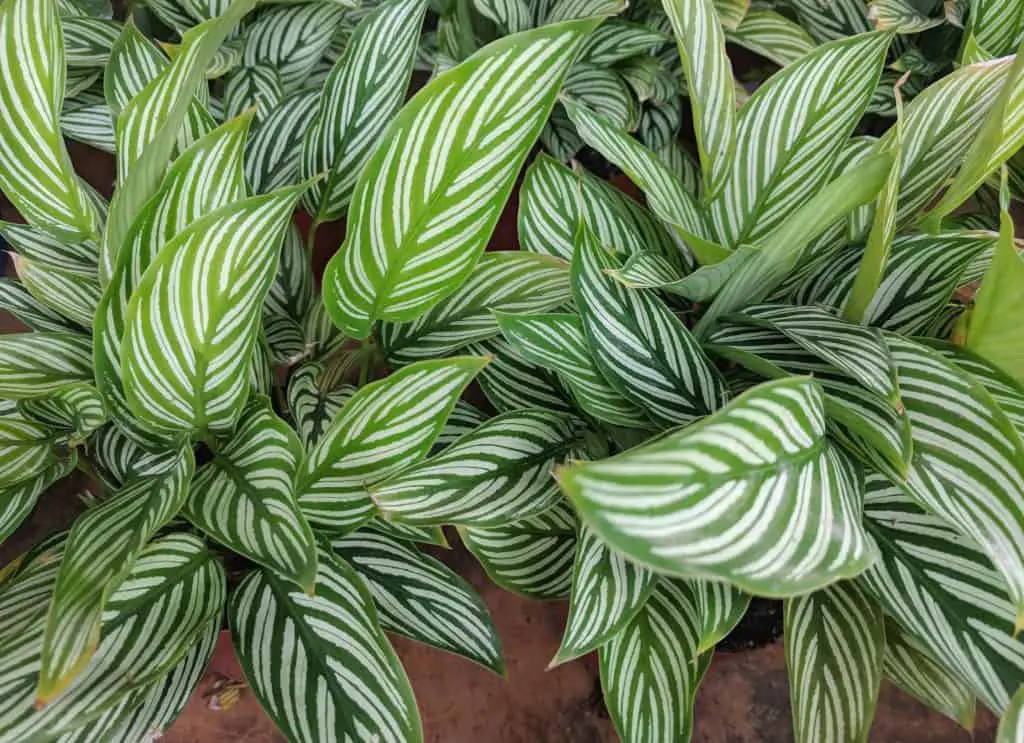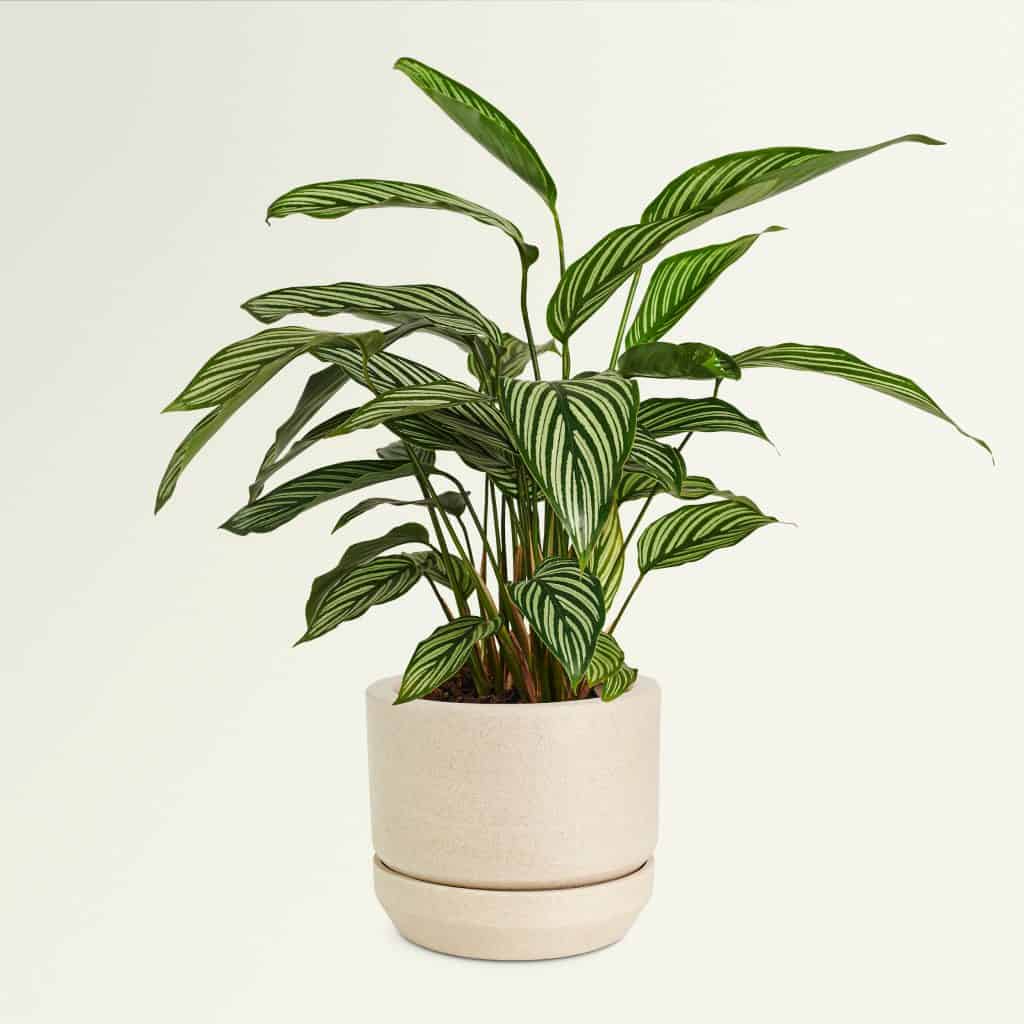Calathea Vittata is a tropical evergreen plant native to rainforests in Brazil, Columbia, and Thailand. The Vittata has distinct and gorgeous deep green leaves with a cream-colored striped variegation. These contrasting colors as well as the long pointy leaves of the Calathea make it easily recognizable. The Calathea Vittata is also an air-purifying plant, making it ideal to keep as an indoor houseplant.
Calathea Vittata Care
The Calathea Vittata has specific care requirements that can make it difficult to grow and maintain, therefore this plant is not recommended for beginners in gardening.
Lighting Requirement
The Calathea Vittata should be given plenty of medium to bright filtered sunlight. Direct sunlight is too intense for the Calathea and can result in leaf burns or browned tips. Providing too little light can be inadequate for this plant as well, especially since the Calathea hates to be overwatered and lower light increases the likelihood of waterlogged roots. Finding an east facing window allows the Calathea to receive dappled morning light while protecting it from more harsh afternoon sun.
Soil Type and pH Requirement
Calathea Vittata requires well-draining aerated soil that also retains enough moisture to keep the plant hydrated. Using a standard potting mix and adding 20% peat moss to retain moisture, as well as 10% perlite to enhance soil drainage is recommended for this plant. Other beneficial additions include activated charcoal, which will assist in absorbing excess water while also preventing diseases and infestations, and orchid bark to improve moisture retention. Ensuring that your soil blend is well-draining is vital for the overall health of your Calathea. The Vittata should also be kept in slightly acidic soil to mimic its natural environment even further. Maintaining a soil pH level of about 6.5 is ideal.

Watering Requirement
The Calathea Vittata is particular about how much water it likes. Keeping the soil moist but not waterlogged is important to keep your Calathea happy and healthy. This plant will require more water during its growing season in spring and summer. During this time, you can water the Calathea once or twice a week. You can monitor the soil with a moisture meter or check the soil with your finger, and if the top two inches are dry that means its time to water it again. During the winter, this plant will become dormant and therefore will require fewer waterings. In colder temperatures the soil will take longer to dry between waterings but keep checking the plant regularly to make sure it is still being kept in damp soil. Watering once every week or two should be enough during this time, but observing your plant is still recommended. When watering the Vittata, make sure the pot has plenty of drainage holes and that the soil is draining well to avoid waterlogging the plant.
Humidity
The Calathea Vittata, as a tropical plant species, loves humidity. Keeping this plant in an environment with a minimum of 50% to 60% humidity is ideal. If your Calathea is kept inside, make sure that you keep it in a humid spot, such as the kitchen or bathroom, or regularly check the humidity levels if you opt for a different location. Misting the plant often can help mimic a humid environment, or you may also use a humidifier or humidity tray. If you choose to use the humidity tray, be sure to keep the tray filled with pebbles so that the Calathea is not sitting in water, which can cause infection in the roots and kill the plant.
Temperature
Keeping your Calathea Vittata in tropical temperatures will be best for this plant. Typically, the Vittata should be kept in temperatures ranging from 65°F to 85°F (18°C to 29°C). While this plant can withstand higher temperatures for a short period of time, prolonged exposure can lead to health issues for your Calathea. Alternatively, the Vittata cannot tolerate cold weather, particularly freezing temperatures, or frost, as it can be very damaging to the plant. When the temperatures drop in fall and winter it is time to bring any outdoor plants inside.
Hardiness Zone
The Calathea Vittata thrives in USDA hardiness zones 9 through 11. If you live outside of these zones your Calathea would benefit from being kept as an indoor houseplant.
Fertilization
Calathea Vittata should be fertilized twice a month during its growing season in spring and summer. Provide this plant with a diluted, slow-release, and water-soluble fertilizer after watering. The Calathea can be sensitive to the salts and chemicals in fertilizer and therefore should not be overfertilized. This plant should also not be fertilized in the winter when it is dormant and has no new growth occurring.

Calathea Vittata Propagation
Calathea Vittata can be propagated through root division. This method is more effective in propagating a Vittata than through stem cuttings. It is usually best to perform the root division during plant repotting. Prepare a smaller separate pot filled halfway with appropriate soil for the root cutting. Once the mother plant is out of its pot, detangle the roots, and use sterile shears to cut a section of healthy roots apart from the rest, making sure to leave the root bulbs intact. Place the root cutting into its new container, cover with soil and water immediately, ensuring that the soil is draining quickly. Find a spot with partial sun to place the new plant and provide with regular care as you wait for the cutting to root and grow new sprouts.
Calathea Vittata Size & Growth Rate
The Calathea Vittata grows upright and can reach up to 24 to 26 inches in height. While this plant is on the smaller side, it can grow quickly when given proper care.
Common Problems with Calathea Vittata
Issues such as pest infestations and diseases in your Calathea are typically a result of inadequate care. Here is a list of some of the common problems you may encounter while caring for your Vittata:
- Leaves that have browned around the edges may be a result of too little water being given to your Calathea. Check the soil for dryness more often than normal to make sure you are not underwatering your plant and check the humidity levels in your Calatheas environment as well.
- Yellowing leaves is a common sign that you are overwatering your Vittata. Take a break from watering your plant and allow more time than normal for the soil to dry before your next watering. Prune any dead, yellow, or wilted leaves from the plant and check the stems and roots for signs of root rot.
- Curling leaves may be caused by underwatering or not enough sunlight. Check the soil of your plant for dryness and provide water if necessary. Alternatively, relocate the plant to a spot that receives higher amounts of indirect sunlight.
- Drooping leaves indicate you may be overwatering your Calathea Vittata. Cease watering immediately and check the roots for any mushy or dark spots. Provide any treatment necessary and allow for a couple extra days before watering or mist the plant instead.
- Calathea Vittata is sensitive to overwatering or being waterlogged, making this plant susceptible to root rot. Root rot is recognizable by the brown, black and soft roots or stems on a plant. Root rot should be treated early to prevent it from spreading and potentially killing your Vittata. Cut away any infected roots and repot into a new clean pot with fresh well-draining soil.
- Calatheas tend to be vulnerable to fungus gnats which will feed on the leaves and stems of the plant. Fungus gnats are attracted to the damp soil needed for this plant. A good preventative measure would be to cover the top of the soil with dry ground to keep the fungus gnats away while still providing your Vittata with the moist soil that it needs.
- Other pests you may find on this plant include spider mites and mealy bugs. Use a spray made from neem oil as preventative care and monitor the leaves and stems of your plants for signs of infestations, such as discoloration or curling leaves. If you do find signs of a pest infestation, isolate your plant, and use a cotton swab dipped in rubbing alcohol to remove and kill the bugs.
How to Repot Calathea Vittata
The Calathea Vittata should be kept in smaller pots to avoid the plant being overwatered or kept in waterlogged soil. This plant will typically only need to be repotted once every two to three years. If you see the plants roots coming through the drainage holes, that is a sign that it does need repotting. However, opt to repot this plant in a pot that is only a couple inches larger than its current one.
Do Calathea Vittata Flower?
Calathea Vittata is not a flowering plant, although the bright colors and unique pattern on the leaves makes it a beautiful plant addition, even without flowers.
Do Calathea Vittata Move at Night?
The Calathea Vittata does move at night. This plant is known as a praying plant, meaning at nighttime the leaves fold up and close in a praying hands motion. The leaves will open again the next day in the presence of sunlight. The interesting movement of the Vittata is one of the many appeals in keeping it as a houseplant.
Are Calathea Vittata Safe for Pets?
Calathea Vittata is not toxic to cats, dogs, or humans. This plant is safe to keep inside with pets and children.
Where Can I Find Calathea Vittata for Sale?
The Calathea Vittata has grown in popularity, making it easier to find in local plant shops. However, you can also purchase this plant online from specialty shops. The typical price for a Vittata will range from $10 to $30, depending upon the size of the plant.
